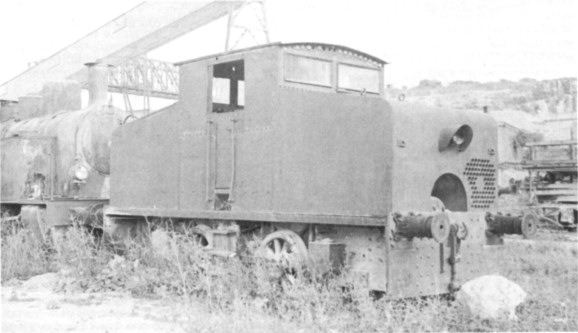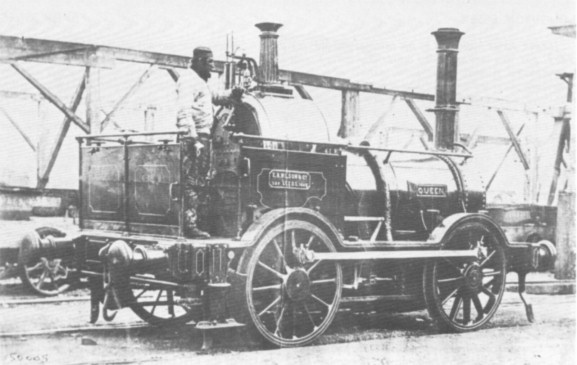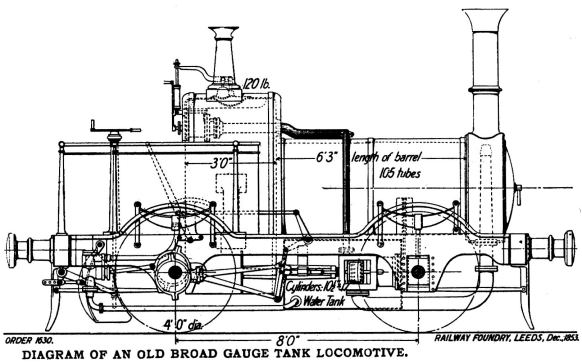
| THE INDUSTRIAL RAILWAY RECORD |
© AUGUST 1973 |
CORRESPONDENCE
MANNING WARDLE PETROL LOCOMOTIVES
I was very interested in the article on page 220 of RECORD 42 as I have recently come across some particulars regarding the careers of three of these locomotives. Carrying running numbers 2‑4 (Manning Wardle 1868‑70 respectively), they were sent to Egypt for service with armoured trains on the Palestine Military Railway. This standard gauge line was built in 1916‑18 from Kantara, on the Suez Canal, through Sinai and Palestine to Haifa. There were two such trains, each apparently consisting of four or more large wagons with the petrol locomotive marshalled in the centre. They carried quick-firing guns and searchlights, and spent most of their time on patrol duties, particularly at night. Both trains went into service in July 1916, the regular locomotives being 2 and 4, with 3 kept in reserve at Kantara. One train was disbanded at the end of December 1918 but the other was sent back to Egypt in 1919 and patrolled the Nile valley for a time. No information is so far available regarding the final disposal of the locomotives.
| CROYDON, SURREY |
HUGH HUGHES |

The unidentified locomotive at Carrières de la Vallée Heureuse et du Haut Banc, September 1967. (G.A.P. Leach)
In connection with the above article in RECORD 42 (page 220) I enclose a photograph of an unidentified 0‑4‑0 internal combustion locomotive at the Carrières de la Vallée Heureuse et du Haut Banc, situated near Rinxent in Northern France. This loco appears to be very similar to the Manning Wardle petrol locomotives discussed in the article. For example, the wheels, frames, sandboxes and footplating appear identical, even down to the pattern of bolt heads on the buffer beam! The body is generally similar, the main difference being the slope of the rear bonnet, although this is explained by the fact that the original engine was replaced by a smaller modern diesel engine and the bonnet was altered to give better visibility. Pocket Book NF (page 37) records this locomotive at Vallée Heureuse as an 0‑4‑0 diesel of unknown make. Originally the Manning Wardle locos had a large cylinder recessed into the side of the rear bonnet, which could be a water cooled exhaust system, and the Vallée Heureuse loco has its exhaust pipe emerging from this position. Perforations in the front of the near bonnet on the photographs are very similar, as are the lamp positions and the lifting rings. The square-cornered cab side cut‑outs are identical although on the Vallée Heureuse locomotive the bottom edges have been plated up and the handrails are longer. The cab front windows are larger but this would be a simple and logical modification. Since there is no sign of a plate having been fitted to the side of the Vallée Heureuse loco I would suggest that - assuming it is a Manning Wardle petrol locomotive rebuilt - it was one of the first batch which only carried painted numbers. Perhaps other members who have visited the quarry have examined this machine more closely than I did. At the time I was more interested in the five 60cm gauge Kerr Stuarts dumped nearby!
| CANTERBURY, KENT |
G.A.P. LEACH |
As Sandford Quarry was originally owned by the Teign Valley Granite Co Ltd I presume the references in Manning Wardle records (page 221 of RECORD 42) apply to this location. I have never heard of any suggestion of Manning Wardle 1954 being at their Devonshire location, but she was a well-known machine at Sandford. Manning Wardle 1996 at Tomatin was obtained from Motor Rail, their No.1970. It is curious to think that with a slight delay in construction the two works numbers could have been identical!
| SOUTH YARDLEY, BIRMINGHAM |
ERIC S. TONKS |
SOME SUGAR MILL LOCOMOTIVES OF INDONESIA
With reference to my article in RECORD 44 (page 274), I examined locomotives 6 and 7 at Pagottan factory but did not see any gearing connecting the outer axles with the coupled ones.
| LOUGHTON, ESSEX |
FRANK JONES |
(Frank Jones indicated in his original manuscript that the wheel arrangement of these locomotives was 2‑6‑2, but this was amended editorially before publication as the engines appear to be provided with the Luttermoller system of semi‑articulation whereby the inner axles are rod coupled in the normal manner. Gears are provided on a splined spherical mounting at the centre of the outer rod driven axles transmitting the drive via an idler gear to the extreme axles. The whole assembly is encased in castings and in effect forms a driven truck at either end of the locomotive giving the weight distribution and adhesive properties of a ten‑coupled locomotive with the rigid wheelbase of a six‑coupled one. Luttermoller, incidentally, was an employee of Orenstein & Koppel. Most locomotives of this type emanated from Orenstein & Koppel, a number being built for main line railways in Germany. Lionel Weiner in "Articulated Locomotives" (Constable, 1930) indicates that fifteen 2ft. 4in. (700mm) gauge 0‑10‑0 tender locomotives were supplied to Java by Orenstein & Koppel; tabulated matter and illustrations also included show that Henschel supplied further similar locomotives. As the gearing was completely enclosed there might well be difficulty in determining its presence except from beneath the locomotive. On the other hand, maintenance problems could have resulted in the removal of the gearing so that the Pagottan locomotives may now be running as 2‑6‑2's. If future visitors to Indonesia care to investigate the position we shall be pleased to report in due course. - Hon Eds)
INDUSTRIAL TERRIERS
Since the appearance of this article (RECORD 44, page 265) I have discovered a further Terrier which served as an industrial locomotive for a few weeks in April 1956 when on loan from British Railways to Bowaters United Kingdom Pulp & Paper Mills Ltd at Sittingbourne, Kent. The engine concerned was 32670 of St Leonards shed, which regularly worked on the Kent & East Sussex line. Originally No.70 POPLAR of the LBSCR, it entered service on 4th December 1872, the last of the first batch of six. No.70 became No.3 BODIAM of the Rother Valley Railway in 1901 (Kent & East Sussex Railway in 1904) and BR 32670 in 1948. Although no further information is known regarding the duties at Sittingbourne it is assumed that it was during a period when one of Bowaters' own standard gauge locomotives was under repair. 32670 is once again named BODIAM, preserved in working order at Rolvenden by the KESR Preservation Society.
| LEICESTER |
H.A. GAMBLE |
(The plea in the photo caption on page 269 brought a quick response from several members. The majority considered the rod structure on the smokebox top to be the operating gear for gravity sanding, although it was also suggested that it might be for the cylinder drain cocks. In addition, a few readers commented on the crude lubricator behind the chimney, possibly for feeding either the regulator valve or the cylinders. - TJL)
QUEEN
I recently purchased a copy of photograph No.50005 of the Locomotive Publishing Co which depicts the broad gauge 0‑4‑0 well tank QUEEN (E.B. Wilson 329 of 1852) of the Torbay and Brixham Railway. On the bottom of this photograph, reproduced by kind permission of Ian Allan Ltd, there appears to be a stamp mark displaying 'I.W. BOULTON ENGINEERS ASHTON-UNDER-LYNE'. Fig 58 in A.R. Bennett's "The Chronicles of Boulton's Siding" illustrates an example of one of four broad gauge E.B. Wilson 0‑4‑0 well tanks which he stated were used on the construction of Portland Breakwater. QUEEN is also mentioned as being built for the Torbay & Brixham Railway but it was actually obtained secondhand by them, though I can trace no details of the seller. It is known that a broad gauge Wilson well tank named QUEEN fell into the sea during the construction of Portland Breakwater, so it would seem likely that QUEEN was purchased by the T&B after the Portland Breakwater contract. Could I.W. Boulton have been associated with the suggested transaction? Bennett states that QUEEN was 'a somewhat larger engine of the same type' when comparing it with the four locomotives purchased by Boulton in 1875, but McDermott in Volume 2 of his "History of the G.W.R." gives the wheel and cylinder diameters of QUEEN as 4ft and 10½in respectively. The four locos bought by Boulton had 4ft wheels and 10½in by 17in cylinders, which suggests that QUEEN was the same size as the others. On comparing the drawing in Bennett's "Chronicles" with my photograph, I find little difference in the form of construction or overall size; the chimney of QUEEN, however, seems slightly taller than those on Boulton's engines. Either Boulton had some connection with the acquisition of QUEEN by the Torbay & Brixham Railway or he obtained a photograph of QUEEN in the assumption that it was the same as the four locos he had purchased and would be of use to show potential purchasers what these machines looked like. Perhaps someone can throw some light on the subject.


This drawing accompanied the photograph of QUEEN in the short feature appearing on page 6 of "The Locomotive Magazine" for January 15th, 1908. The contractor for the breakwater [? only part of it] was said to be a Mr Coode who founded the firm of Coode, Son & Mathews. It will be noted that the drawing is dated December 1853, yet QUEEN's worksplate was quite definitely dated 1852.
| LONG EATON, NOTTINGHAM |
B.W.LACEY |
(Some notes on the Breakwater and various railways at Portland may be found elsewhere in this issue. - KPP)
WICK BREAKWATER
Whilst reading a copy of "Scotland's Magazine" for March 1972 I noticed an article on the Wick Breakwater scheme of the 1855‑65 period - a fantastic project aimed at enlarging Wick harbour by means of an enormous breakwater. The engineer was Robert Stevenson, father of the poet Robert Louis Stevenson, who was in fact appointed an assistant engineer to the project in an attempt to get him to take up a "proper" profession! The breakwater was almost finished before the sea took exception to it, but from then on bits kept breaking off until by about 1870 there was just a stump left on the shore. One broken "fragment" weighed 2,600 tons and was hurled some 300 yards! There was a substantial railway system on the contract and a photograph with the article showed a vertical-boilered loco at work on the breakwater - from the look of it probably a Chaplin. Does anyone have any information about this scheme or its locomotive(s)?
| KENILWORTH, WARWICKSHIRE |
RODNEY WEAVER |